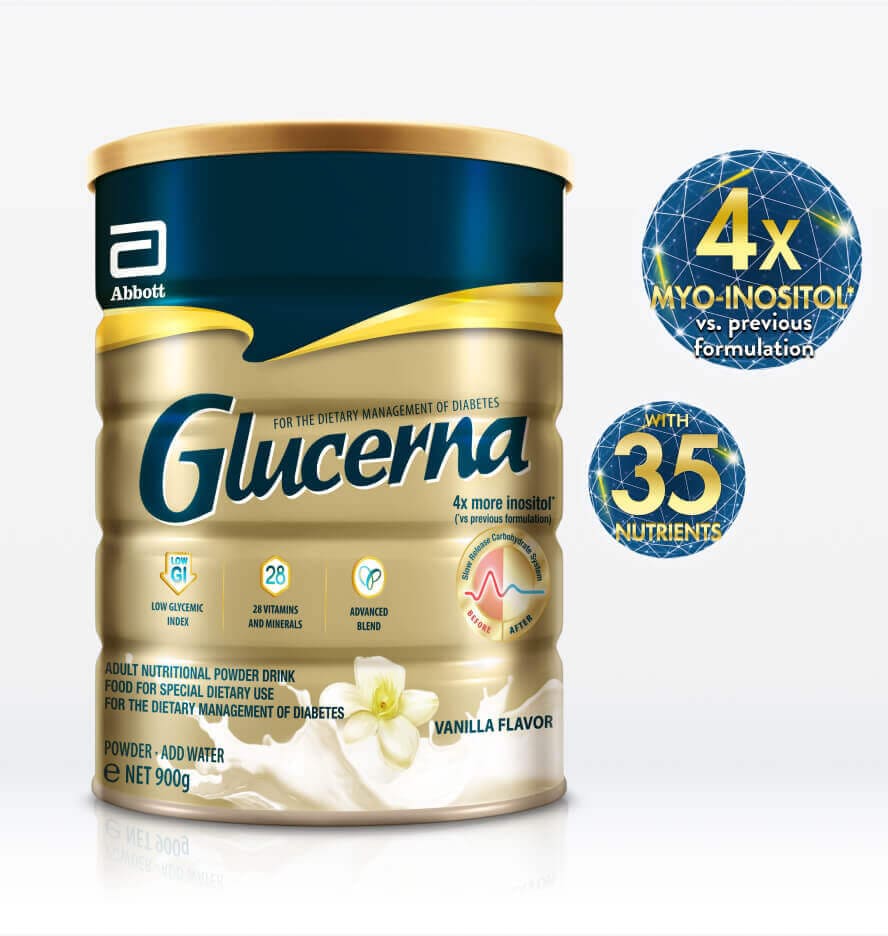Glucerna Vanilla Flavor
- Title
- Glucerna® Vanilla Flavor
- Detail Page Path
Proper nutrition is the foundation of diabetes care. Learn more about eating right for diabetes to help keep your blood sugar in check. What you eat, how much, and when you eat can impact your blood glucose levels. But you do not need to go on a special diet - the diabetic diet is simply a healthy eating plan that helps with blood sugar control.
1. Enjoy a variety of food from different food groups in appropriate portions.
2. Take note of carbohydrates & include low GI options.
Carbohydrates are the body’s main source of energy, fueling our daily activities. You can get it from whole grain foods (e.g. brown rice, whole meal bread, and oats), vegetables, fruits, and beans. These are also rich in fiber and other nutrients and may help with blood glucose management. If you have diabetes, you need to moderate your carbohydrate intake. Carbohydrates have the greatest and most immediate impact on blood sugar levels. Food and drinks with added sugar, such as cakes and soft drinks, should be limited as they often have low nutritional value.
Consider choosing low or medium GI (glycemic index) food options over those with high ones. Consumption of food that’s high in GI will cause a higher peak in your blood sugar, compared to one with low or medium GI. You should aim to avoid high GI foods to help manage blood sugar, as well as to help sustain energy throughout the day.
GI, or glycemic index, is a ranking of carbohydrates on a scale from 0 to 100 according to the extent to which they raise blood sugar levels after eating.
High GI food has a GI of 70 or more, whereas medium GI food has a rating of between 56 and 69. Food low in GI has a rating of 55 or less.
3. Manage Your Fat Intake
Watch your total fat intake to help manage your weight. Also, limit your consumption of saturated fat and trans-fat which can increase the risk of developing heart disease. Here are some tips to help reduce your intake of these “bad” fats:
4. Reduce intake of salt & canned food.
Use less salt and sauces, on your diabetic diet, and cut down on eating canned, preserved or processed foods. These contain a lot of sodium, and a diet high in sodium can increase your blood pressure. Try flavoring foods with herbs and spices instead.
5. Have a regular diabetic meal schedule.
Stick to your regular mealtimes, and space out your meals and snacks for the day.
Every choice matters. Learn tips on how you can make smarter beverage choices everyday to help you make a big difference in managing diabetes.
Enjoy the holiday festivities and manage your blood sugar levels with these easy tips, tricks and swaps.
Foot ulcers are a common complication of diabetes. Poor nutrition can increase the risk of foot ulcers and delay healing. Learn about the importance of nutrition to support people with diabetes and foot ulcers.
Glucerna® is the number 1 selling diabetes nutritional supplement in the world*. It contains 35 nutrients, slow-release carbohydrates and 4x more inositol vs previous formulation, that delivers a dual action for tight blood sugar control.
* Euromonitor International Limited; total global retail sales in 2023 for diabetic diet enhancer drinks that are not marketed as a meal replacement product. Euromonitor and Abbott calculation based in part on custom research conducted between October and November 2023 and Euromonitor Passport Consumer Health 2023 based on 2022 data.

You are about to exit for another Abbott country or region specific website.
Please be aware that the website you have requested is intended for the residents of a particular country or region, as noted on that site. As a result, the site may contain information on pharmaceuticals, medical devices and other products or uses of those products that are not approved in other countries or regions.
The website you have requested also may not be optimized for your specific screen size.
Do you wish to continue and exit this website?
Stay Connected